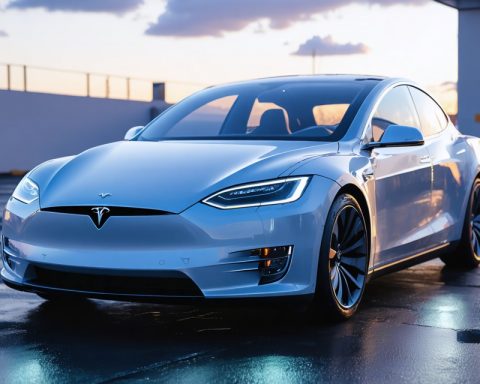- Stanford University’s SLAC-Stanford Battery Center has discovered that EV batteries could last 30% longer in real-world conditions than previously estimated.
- The study used realistic testing scenarios, moving away from traditional recharge cycles to better reflect everyday driving conditions.
- This discovery could reduce financial and environmental costs by prolonging EV life and diminishing the need for new vehicles and replacement batteries.
- Longer-lasting batteries may enhance EV resale values, with detailed battery health reports potentially increasing resale prices by an average of $1,400.
- This breakthrough aligns technology with sustainability, contributing to a promising, eco-friendly future in transportation.
Beneath the sleek exteriors of modern electric vehicles (EVs), a quiet revolution is brewing. Researchers at Stanford University’s SLAC-Stanford Battery Center have rocked the automotive world with revelations that could redefine the future of sustainable motoring. Their latest findings suggest that EV batteries may possess far greater endurance than previously estimated, offering a glimmer of excitement to eco-conscious drivers.
In a study that reimagines traditional battery testing, these scientists delved into real-world scenarios to evaluate battery performance. Unlike the conventional tests that rely on repetitive recharge cycles, this pioneering research embraced the chaotic rhythm of everyday life. From the sluggish creep through congested traffic to the sleek glide down an open freeway, the tests aligned closely with actual driving conditions. Such authenticity in testing unveiled a remarkable truth: under realistic conditions, EV batteries could outlast previous predictions by about 30%.
The implications of this discovery extend far beyond the laboratory. As global EV sales surge, hitting a milestone with over a million units sold in the United States in 2023 alone, the prospect of a longer battery lifespan holds transformative potential. For drivers, this could mean extending the life of their vehicles, reducing the environmental and financial costs associated with buying new cars and replacement batteries.
Furthermore, a longer-lasting battery boosts resale values, a crucial factor in an era where resale plays an increasingly vital role in the lifecycle of EVs. Services like Recurrent, which actively monitor an EV’s battery health, empower sellers by providing detailed battery reports. This transparency not only enhances selling power but can increase resale prices by an average of $1,400 compared to those who forgo such insights.
This breakthrough in understanding EV batteries represents more than just an academic triumph. It symbolizes a symbiotic relationship between technology and eco-friendliness, whispering a promise to future proof our roads. As we advance into a new age of transportation, the humble battery stands as a silent guardian, its newfound longevity paving the way for a sustainable tomorrow.
Stanford’s EV Battery Breakthrough: What It Means for the Future of Sustainable Driving
Introduction
Electric vehicles (EVs) are gaining traction worldwide, and recent groundbreaking research from Stanford University’s SLAC-Stanford Battery Center suggests that these vehicles may last longer on the road than previously thought. This revelation not only excites eco-conscious drivers but also promises to redefine the landscape of sustainable transportation.
Extended Battery Life: The Game Changer
In a study deviating from traditional battery tests, Stanford researchers evaluated EV batteries in real-life driving scenarios rather than relying on repetitive recharge cycles. This approach uncovered that, under realistic conditions, these batteries could surpass previous longevity estimates by about 30%.
How-To Steps & Life Hacks for Extending Battery Life
1. Avoid High Speeds: Continuous high-speed driving can degrade the battery faster.
2. Charge Smartly: Charge your EV between 20% and 80% to prolong battery life.
3. Monitor Battery Health: Use services like Recurrent to get real-time insights into your battery’s condition.
Real-World Use Cases
Longer-lasting batteries imply fewer replacements and extended vehicle life, reducing both environmental impact and financial outlay. As EV sales climb, the implications for consumer savings and ecological benefits are significant.
Market Trends: Rising EV Sales and Battery Tech
EV sales reached a milestone in the U.S. with over a million units sold in 2023. As demand for EVs increases, so does the emphasis on battery longevity, impacting market dynamics and consumer expectations.
Reviews & Comparisons
The ability to monitor an EV’s battery health, as offered by services like Recurrent, can enhance resale values by as much as $1,400. Transparency in battery health boosts consumer trust and resale potential.
Features & Pricing
Long-lasting batteries not only promise reduced running costs but also contribute to a higher resale value. As battery technology advances, initial EV costs may decrease, offering a broader market appeal.
Pros & Cons Overview
Pros:
– Longer vehicle lifespan
– Higher resale value
– Fewer resources required for battery manufacturing and disposal
Cons:
– Initial costs of EVs remain higher compared to conventional vehicles
– Charging infrastructure still needs expansion
Security & Sustainability
With enhanced battery longevity, the ecological footprint of EVs diminishes, contributing to sustainability goals. This breakthrough aligns with global efforts to reduce reliance on fossil fuels.
Insights & Predictions
Given the findings from Stanford, the future of EVs appears increasingly promising. Battery technology will continue to evolve, possibly reducing costs and extending ranges further, encouraging broader adoption of electric transportation.
Actionable Recommendations
– Adopt EVs: If you’re considering a switch, now is an excellent time as battery technology advances.
– Maintain Your Battery: Proper maintenance and monitoring can extend your EV’s life significantly.
– Consider Resale Options: Utilize battery health monitoring to improve resale potential.
For more on the impact of EVs and technology advancements, visit Stanford University.
Conclusion
Stanford University’s revelations mark a significant step forward in the journey toward sustainable motoring. The humble EV battery, with its newfound endurance, could spearhead a revolution in personal transport, making the dream of a green automotive future that much closer.
—
This article provided comprehensive insights into the implications of Stanford’s findings, offering practical advice and analysis to understand better and capitalize on the evolving EV landscape.










